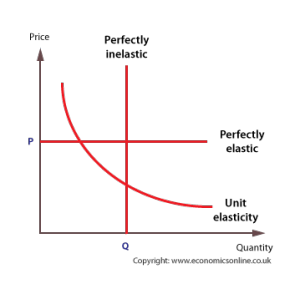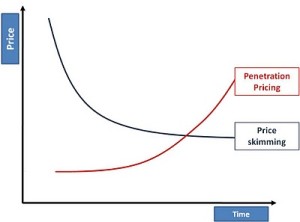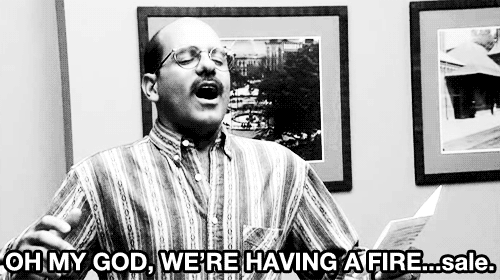Pricing.
I could write a book on this one word alone. Pricing can make a business, it can break a business, and it can also drive business owners insane. There’s often no rhyme or reason to prices that work vs. prices that don’t work – every single business (and shopper) out there does things a little differently. Since day one as a business owner, I’ve struggled like crazy to identify the ecommerce pricing strategy that consistently works for me. While the struggle continues, I think I’ve gotten my head around it a bit better.
The revenue from customer purchases is just another of many metrics you contend with on a daily basis, along with things like website hits, marketing dollars spent, conversion rates observed, social media followers added… when managing an ecommerce business, the prices that lead to generating this revenue can get lost in the fold.

Take my advice though, price is possibly the most important metric you’ll deal with – so give it the attention it deserves. Put simply, price is the best way in which you can manipulate and control demand for the products or services that your business sells.
Price drives all of the other metrics above.
The relationship between the price of a product and the subsequent demand for it is called price elasticity of demand. If you’re unfamiliar with this concept, be sure to read into it – your ecommerce success might just hinge on your understanding of how this works.
I’ve seen businesses go under for charging too little; I’ve also seen businesses go under for charging too much. If you want to be successful in ecommerce, you’ve got to understand ecommerce pricing strategy sooner rather than later.
Here are a few ways I’ve observed pricing affect an ecommerce business:
- Low prices can lead to huge sales boosts
- High prices can lead to little or no sales at all
- Low prices drive demand from price sensitive customers
- High prices automatically make your products or services less appealing to price sensitive customers, but more appealing to higher end, premium clients
- Price changes can lead to vastly fluctuating conversion rates on your website
- Price changes can destroy, as well as solidify, your overall margins and profitability
- Pricing alone can determine the fate of your company
Low prices are wrong
I’m putting my neck on the line here to say that I think low prices are wrong. The problem is no one cares what I think.
In life, there’s a saying that you “get what you pay for” – and that’s true. If you pay little for something, expect low quality in return. I can cite 10 or more examples where I’ve found products for less money, bought them, and they’ve turned out to be garbage. I can also cite examples where the product quality was decent, but the overall service provided by the seller was poor.
A couple of years ago I found a label supplier charging half the price of my existing supplier. I saw savings and switched. From day one I had nothing but problems – the adhesive on the cheaper labels was weak, most of the labels fell off in the mail, meaning lots of customers never even received their packages! For the sake of two or three cents per label, it was a stupid decision on my part. I went back to the more expensive supplier soon after, with my tail between my legs.
The latest example I can cite occurred just a couple of weeks ago. We go through thousands of mailing bags each week for small products that we ship. I decided to go with another supplier, because they were 50% cheaper than our existing supplier. 50%!…
Exact same story: when the bags arrived, half of them were missing a sticky flap, half of them had no seal on the bottom (so items went in the top and fell straight out the other end), and the rest were really weak. So, again, by trying to pay less for something, I ended up shooting myself in the foot. You’d think I learned my lesson the first time…?
I’m willing to bet most of you have similar stories…
I believe low prices are wrong because they undermine the essence of the retail exchange and lead to mutual disappointment on both ends.
But people like cheap stuff
Yep, people like cheap stuff. Just because you and I realize being the cheapest leads to long term disappointment (for both parties), the fact is, the masses of customers out there love cheap goods.
Sure, they’ll probably regret buying cheap when it turns out what they’ve purchased is trash, but initially, people love buying low priced products. This means that if you sell cheap stuff, you can be sure that you’ll move lots of it. No one likes to pay more than they have to – we all like to think we’ve gotten a bargain.
Look at car buying… lots of things are important to you: safety, interior, style, engine, color. By far the biggest factor in the decision though is PRICE. For some reason, we all gravitate toward the cheaper items, whether it’s a car, a meal, a piece of furniture… anything.
The majority of people make buying decisions based on price, as evidenced by the price elasticity of demand theory. When they compare your item to an item from another ecommerce store, all things being roughly equal, they’ll almost always buy the cheaper of the two.
Pricing strategies
There are various strategies out there you can use in order to determine how you price your goods. Let’s look at a few of my favorites, as well as some that you may or may not have experimented with in the past.
Price penetration
My favorite pricing strategy – it’s basically where you start selling an item really cheap, then as popularity and sales grow, you gradually crank up the price. This particular strategy is ideal for launching new product lines or new websites – it’s also good for use on platforms like Amazon and eBay, by selling lots of items cheap initially you can rise right up the best match search listings. By the time you put your prices up, the idea is to be near the pinnacle of those listings – selling lots of items for top dollar.
Price testing
Another strategy I’m fond of is A/B testing your price. That just means to change the price of your products over a fixed period (ideally to an equal number of visitors) so that you can determine which price point yields the best result. So for example 10 people hitting your website might see the price of a product at $9, 10 more people might see the price at $5. The idea of A/B testing isn’t necessarily to see which price shifts the most units (because that will invariably be the lowest priced item) – the idea is to see which price generates the most profit. You might ship 20% less items at the $9 price point, but you might be making 100% more profit – in which case it makes business sense to charge the higher price.
Low price leader
An unfortunate (though effective) pricing strategy employed by ecommerce business owners is to undercut everyone else. As I’ve already mentioned, however, there is always someone out there willing to go lower than you are – it’s a race to the bottom, and nobody wants to see a fire sale.
Remember to look at the bigger picture when setting prices – you might be making one or two dollars gross profit per sale, but how much are you actually making when you’ve factored in fixed costs, and variables like PPC advertising? Undercutting competition can seem like a fantastic pricing strategy, but it’s not. Someone will always go lower than you – you simply can’t win (unless your name is Jeff Bezos or Sam Walton).
“Good/Better/Best” merchandising
My final pricing strategy isn’t product-specific. On all of my websites, I like to give users as much choice as possible in terms of style, sizes, colors and so on. I also like to give them a huge choice in terms of price.
If you take a look at the ecommerce site in my bio, you’ll see we stock eyelashes from $2 per box right up to $40 per box. I’ve done this for a reason: to offer price sensitive customers an option they can afford, as well as to cater to my customers looking for top end, premium items. This isn’t a product pricing strategy as much as a merchandising strategy, and I would encourage you to push both ends of the pricing spectrum, particularly the high end.
For better insight into pricing a spectrum of goods, make sure you read up on price anchoring! You may find you can use the perceived value of your high-end products to drive significant views and sales to your mid- and low-tier items.
Pricing strategy affects marketing, too…
I know people who pour tens of thousands of dollars into PPC advertising on a monthly basis. They think that the more cash they throw at driving traffic, the better odds of finding that tipping point for profitability. That’s just not how it works… not at all.
You can tweak landing pages and layouts, you can tweak ad copies and keyword bids (more on this very soon in a future post), but if your prices aren’t right, it’ll all be in vain. Not so long ago I was pulling my hair out – sales on one of my websites plateaued. I couldn’t increase them no matter what I did. The last thing I wanted to do was lower my price, but in the end I bit the bullet and reduced prices by around 10% across the board.
That reduction in price lead to a 30% increase in sales, and a 25% increase in average check.
The little margin I sacrificed to implement the price decrease was more than made up in the increased sales volume, and gross sales figures, that resulted. I also saw PPC conversions leap by 2 points across the board.
What I’m trying to say here is that you must be receptive to changing your prices. You can execute the very best marketing campaign in the world, but there’s every chance you could make zero sales as a result, purely because your prices are set too high.
Instead of focusing purely on driving more traffic to your website, ensure you’ve laid the foundations for success first by optimizing your ecommerce pricing strategy.
Final thoughts
When I started out in ecommerce I thought everyone would play nice. I thought everyone would adhere to manufacturer MSRP, and I also thought I could say “well, this item cost me $4 to buy, so I’d like to sell it at $8 for a 100% markup”. That’s not how it works – essentially your customers will decide your pricing for you. If the price isn’t right, you won’t make many sales.
I battle with prices on a daily basis. It’s something every retailer must be willing to do. Don’t just set your prices when you add products to your website and hope for the best. Re-visit your ecommerce pricing strategy on an ongoing basis to ensure you’re not leaving profit on the table.






6 thoughts on “Choosing Your Ecommerce Pricing Strategy”
Pingback: How To Start An Amazon Business - Startup Jungle
Pingback: How To Start An Amazon Business - Startup Jungle
Pingback: How To Start An Amazon Business - Startup Jungle
Hi Nick.
I have a products that will cost me $4.06(product+shipping) What do you think is a good price point to start selling that item…my goal is to increase sales/conversions.
See the attached product…
Best regards,
Rick
Hi Nick.
I have a products that will cost me $4.06(product+shipping) What do you think is a good price point to start selling that item…my goal is to increase sales/conversions.
See the attached product…
Best regards,
Rick
Hi Nick.
I have a products that will cost me $4.06(product+shipping) What do you think is a good price point to start selling that item…my goal is to increase sales/conversions.
See the attached product…
Best regards,
Rick